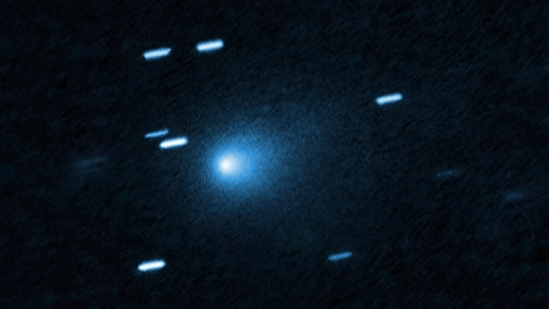A mysterious comet, 3I/ATLAS, has reached its closest point near the Sun today, on October 29. Scientists are closely observing how it behaves. Many people believe it can reveal whether this interstellar visitor is a natural object or something more extraordinary.
Is comet 3I/ATLAS an alien spacecraft or a natural visitor? Scientists say its closest approach could reveal the truth(AP)
The Comet’s closest approach, known as perihelion, happened at 11:47 a.m. UT, (7:47 a.m. Eastern Time). According to Harvard professor Avi Loeb, this is a key moment, what he calls the comet’s “acid test.” He says that if 3I/ATLAS were a spacecraft, this would be the best time for it to change direction or speed.
Also read: 3I/ATLAS update: Harvard scientist warns Manhattan-sized comet could be rare ‘black swan event’
The third visitor from beyond
So far, NASA and astronomers describe it as the third known object from outside our solar system to pass through our neighborhood, after the famous ‘Oumuamua (in 2017) and 2I/Borisov (in 2019). The Hubble Space Telescope has even captured detailed images of it as it travels through space.
Strange signs raise questions
Professor Loeb, known for his open-minded approach to alien technology, believes 3I/ATLAS is “most likely natural,” but says it shows eight unusual traits that make it different from typical comets. He gives it a 4 out of 10 on what he calls the Loeb Scale, where 0 means definitely natural, and 10 means definitely technological.
Among its strange features:
• Its orbit is aligned very closely with the orbits of planets, something extremely rare.
• During July and August, it showed a sunward jet or “anti-tail” that is not an optical illusion.
• It is a million times more massive than ‘Oumuamua, and much larger than 2I/Borisov.
Natural or artificial?
If it is a natural comet, Loeb says the Sun’s heat could cause it to break apart and release a bright cloud of gas and dust. But if it is something artificial, it might maneuver, shine brighter, or release small probes, possible signs of advanced technology.
What happens next?
NASA confirms that 3I/ATLAS poses no threat to Earth and will remain far away from our planet. Scientists will continue to observe it in the coming months to learn more about its nature.
As Loeb told Newsweek, “The possibility of alien technology would be huge, and we must take it seriously. Nature often surprises us more than any science fiction story ever could.”
FAQs:
1. What is Comet 3I/ATLAS?
Comet 3I/ATLAS is an interstellar object currently passing through our solar system. It’s the third known visitor from outside our solar neighborhood, after ‘Oumuamua and Borisov.
2. Why do scientists think 3I/ATLAS could be an alien spacecraft?
Some scientists, including Harvard professor Avi Loeb, believe the comet shows unusual features, like its orbit alignment and massive size, that could hint at a technological origin.
3. Is Comet 3I/ATLAS dangerous for Earth?
No. NASA confirms that 3I/ATLAS poses no threat to Earth and will stay far away as it passes the Sun.
Images are for reference only.Images and contents gathered automatic from google or 3rd party sources.All rights on the images and contents are with their legal original owners.

